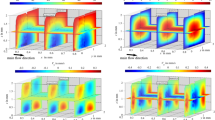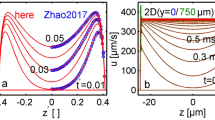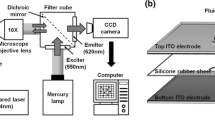Abstract
The micro-LIF (laser-induced fluorescence) technique was applied to the measurement of pH distributions in a chemically reacting flow in a microfluidic device. Two liquid streams were combined at the junction of a Y-shaped microchannel (100-μm width and 33-μm depth), and allowed to diffuse into each other and react. The results for non-reacting fluids (hydrochloric acid and water) show good agreement with theoretical values calculated using conventional diffusion. When a reaction occurred (hydrochloric acid and sodium hydroxide), a large difference between the measurement results and the theoretical values was observed, indicating rapid proton diffusion compared with the theoretically calculated values.





Similar content being viewed by others
References
Choi J, Hirota N, Terazima M (2001) A pH-jump reaction studied by the transient grating method: photodissociation of o-nitrobenzaldehyde. J Phys Chem A 105:12–18
Frongillo Y, Goulet T, Fraser MJ, Cobut V, Patau JP, Jay-Gerin JP (1998) Monte Carlo simulation of fast electron and proton tracks in liquid water. II. Nonhomogeneous chemistry. Radiat Phys Chem 51:245–254
Hibara A, Tokeshi M, Uchiyama K, Hisamoto H, Kitamori T (2001) Integrated multiplayer flow system on a microchip. Anal Sci 17:89–93
Ho CM, Tai YC (1998) Micro-electro-mechanical systems (MEMS) and fluid flows. Annu Rev Fluid Mech 30:579–612
Inoue S, Spring KR (1997) Video microscopy: the fundamentals, 2nd edn. Plenum Press, New York
Johnson TJ, Ross D, Locascio LE (2002) Rapid microfluidic mixing. Anal Chem 74:45–51
Kamholz AE, Yager P (2001) Theoretical analysis of molecular diffusion in pressure-driven laminar flow in microfluidic channels. Biophys J 80:155–160
Kamholz AE, Schiiling EA, Yager P (2001) Optical measurement of transverse molecular diffusion in a microchannel. Biophys J 80:1967–1972
Kataoka DE, Troian SM (1999) Patterning liquid flow at the microscopic scale. Nature 402:794–797
Kim HJ, Kihm KD, Allen JS (2003) Examination of a ratiometric laser induced fluorescence thermometry for microscale spatial measurement resolution. Int J Heat Mass Trans 46:3967–3974
Koch M, Chatelain D, Evans AG, Brunnschweiller A (1998) Two simple micromixers based on silicon. J Micromech Microeng 8:123–126
Liu RH, Stremler MA, Sharp KV, Olsen MG, Santiago JG, Adrian RJ, Hassan A, Beebe DJ (2000) Passive mixing in a three-dimensional serpentine microchannel. J Microelectromech Syst 9:190–198
Shinohara K, Sugii Y, Okamoto K, Madarame H, Hibara A, Tokeshi M, Kitamori T (2004) Measurement of pH field of chemically reacting flow in microfluidic device by laser-induced fluorescence. Meas Sci Technol 15:955–960
Stroock AD, Dertinger SKW, Ajdari A, Mezic I, Stone HA, Whitesides GM (2002) Chaotic mixer for microchannels. Science 295:647–651
Sugii Y, Okamoto K, Hibara A, Tokeshi M, Kitamori T (2003) Stabilization of interface between two liquid phases on a microchip by means of micro PIV technique. In: Prenel JP, Bailly Y (eds) Proceedings of the 4th Pacific symposia on flow visualization and image processing (PSFVIP-4), Chamonix, France, June 2003. Presses Universitaires Franc-Comtoises, Besancon, p 52
Tokeshi M, Minagawa T, Uchiyama K, Hibara A, Sato K, Hisamoto H, Kitamori T (2002) Continuous flow chemical processing on a microchip by combining micro unit operations and a multiphase flow network. Anal Chem 74:1565–1571
Weigl BH, Yager P (1999) Microfluidic diffusion-based separation and detection. Science 283:346–347
Whitesides GM, Stroock AD (2001) Flexible methods for microfluidics. Phys Today 54:42–48
Wu Z, Nguyen NT, Huang X (2004) Nonlinear diffusive mixing in microchannels: theory and experiments. J Micromech Microeng 14:604–611
Acknowledgements
The authors wish to thank Prof. Madarame of the University of Tokyo, Japan for the fruitful discussions related to this work. This work was partly supported by a Grant-in-Aid for Scientific Research (B) 15360092, from the Ministry of Education, Culture, Sports, Science and Technology, Japan.
Author information
Authors and Affiliations
Corresponding author
Rights and permissions
About this article
Cite this article
Shinohara, K., Sugii, Y., Hibara, A. et al. Rapid proton diffusion in microfluidic devices by means of micro-LIF technique. Exp Fluids 38, 117–122 (2005). https://doi.org/10.1007/s00348-004-0906-z
Received:
Accepted:
Published:
Issue Date:
DOI: https://doi.org/10.1007/s00348-004-0906-z




